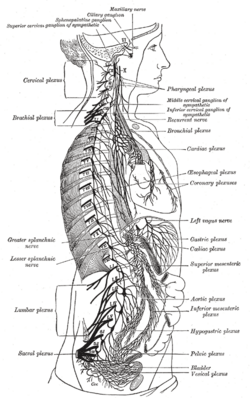Celiac plexus facts for kids
Quick facts for kids Celiac plexus |
|
|---|---|
 |
|
| The right sympathetic trunk and its connections with the thoracic, abdominal, and pelvic plexuses. (Celiac plexus labelled at center right.) | |
 |
|
| The celiac ganglia with the sympathetic plexuses of the abdominal viscera radiating from the ganglia. (Label for celiac plexus at top center.) | |
| Latin | plexus coeliacus |
The celiac plexus, also known as the solar plexus, is a special group of nerves in your body. Think of it like a control center for many important organs in your belly. It's called the "solar plexus" because its nerve fibers spread out like rays from the sun.
This nerve network is found deep inside your abdomen. It sits near big blood vessels like the celiac trunk and abdominal aorta. You can find it behind your stomach and in front of your diaphragm, which is the muscle you use to breathe. It's usually around the level of your first lower back bone.
The celiac plexus is made up of different nerves working together. These include the greater and lesser splanchnic nerves. It also gets fibers from the vagus nerves, which are very important for controlling many body functions.
The main part of the celiac plexus includes groups of nerve cells called celiac ganglia. These ganglia are connected by many nerve fibers, forming a complex web. Other nerve groups, like the aorticorenal ganglia, are often considered part of this important plexus.
Contents
Understanding the Solar Plexus
The celiac plexus is a big bundle of nerves. It helps control many things in your digestive system. It sends signals to and from your brain. This helps your body manage digestion and other belly functions.
Where is the Celiac Plexus Located?
The celiac plexus is located deep inside your upper abdomen. It's behind your stomach and pancreas. It sits in front of your spine, near where several major arteries branch off. This central spot allows it to connect to many organs.
Nerves That Form the Plexus
The celiac plexus is formed by several key nerves. These include the splanchnic nerves, which carry signals from your spinal cord. It also receives input from the vagus nerves. The vagus nerves are part of your body's "rest and digest" system.
Parts of the Celiac Plexus
The celiac plexus is like a main hub. From this hub, many smaller nerve networks branch out. These smaller networks go to specific organs. They help control how those organs work.
- Hepatic plexus: This part goes to your liver.
- Splenic plexus: This part goes to your spleen.
- Gastric plexus: This part goes to your stomach.
- Pancreatic plexus: This part goes to your pancreas.
- Suprarenal plexus: This part goes to your adrenal glands.
Nerve Networks That Branch Off
Other important nerve networks come from the celiac plexus. These branches help control even more organs. They make sure different body parts can communicate with each other.
- Renal plexus: This goes to your kidneys.
- Testicular plexus / ovarian plexus: These go to the reproductive organs.
- Superior mesenteric plexus: This goes to your small and large intestines.
See also
 In Spanish: Plexo solar para niños
In Spanish: Plexo solar para niños


